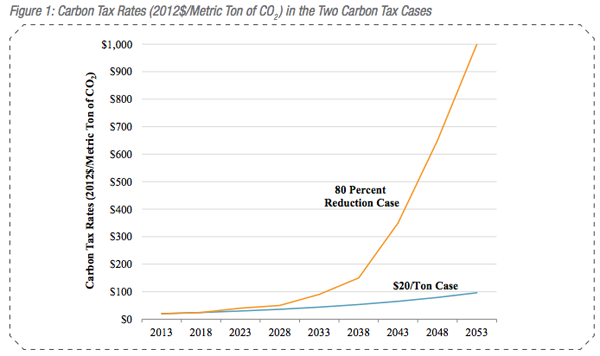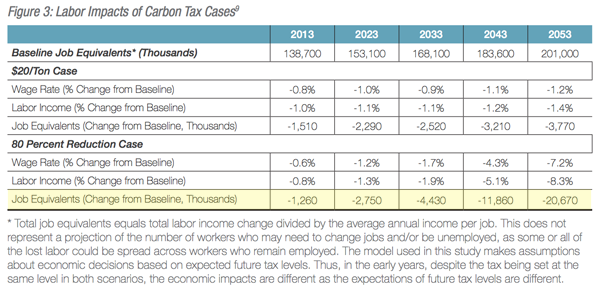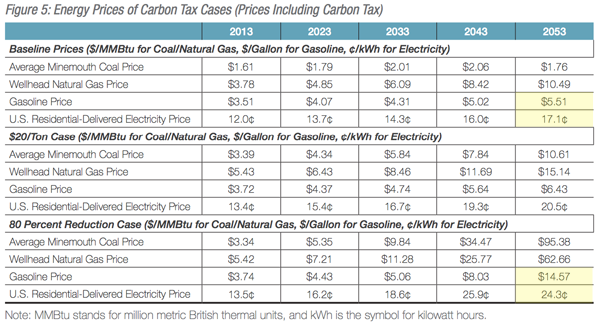A recent story in EnergyGuardian (sub. req’d) centered on Senator Sheldon Whitehouse’s (D-R.I.) support for the carbon “fee” bill introduced by his colleagues Sen. Barbara Boxer and Sen. Bernie Sanders. Fortunately, the newly-released NERA study gives us a quantitative estimate of how much their scheme would hurt the U.S. economy. The whole episode fulfills the warnings that many of us have been making during the carbon tax debate. Specifically, advocates of a carbon tax rely on a bait-and-switch, where they make wild promises about the alleged environmental benefits of a relatively modest tax rate. As the NERA study shows, however, if the tax rate is modest, the environmental impact is negligible, but if the rate is high enough to really reduce U.S. carbon dioxide emissions, the economic impacts are absolutely devastating.
The Boxer-Sanders “Fee”: Bait-And-Switch
The specific legislation proposed by Boxer and Sanders describes itself in this way:
Price Carbon — While setting a long-term emissions reduction goal of 80 percent or more by 2050 as science calls for, the legislation would enact a carbon fee of $20 per ton of carbon or methane equivalent, rising at 5.6% a year over a ten-year period….The Congressional Budget Office estimates this step alone could raise $1.2 trillion in revenue over ten years and reduce greenhouse gas emissions approximately 20 percent from 2005 levels by 2025. Additional emissions reduction under this legislation would occur as a result of the energy investments, and ongoing efforts by the EPA and a number of states. [Bold added.]
Now the part I have put in bold is crucial, and it epitomizes exactly what I was saying in my post about the new NERA study. The proponents of a carbon tax (or “fee” as Boxers and Sanders are euphemistically calling it) want to have their cake and eat it too. On the one hand, they point to the “settled climate science” to show why a drastic and aggressive reduction in U.S. emissions is extremely important.
On the other hand, they know that most Americans would never support the policies necessary to actually achieve such aggressive reductions. Therefore, the proponents of a carbon tax do what Boxer and Sanders have done in the block quote above: They point to a relatively modest carbon tax level, which will only cause mild suffering for lower-income households and workers.
But since this level of the carbon tax won’t achieve the allegedly necessary emissions reductions, they then tell a magic-bullet story about using the proceeds of the carbon tax to fund all sorts of new technologies that will then render conventional energy production obsolete. That’s how they can sell the whole package to Americans as (a) achieving the drastic emission cuts by 2050 that they say are necessary, while (b) not imposing the carbon taxes upfront that the same models say are necessary to achieve part (a).
What Does NERA Say About an 80 Percent Reduction?
A new study by NERA Economic Consulting, prepared for the National Association of Manufacturers (NAM), perfectly describes the impacts on the US economy from the two “endpoints” of the Boxer/Sanders bait-and-switch. In other words, if the government really does stick to just a modest tax that rises gently over time, then the NERA study tells us the outcome. On the other hand, if the carbon tax gets its foot in the door, and then the hoped-for innovations in “clean energy” don’t materialize so that future policymakers jack up the carbon tax, then the NERA study shows how bad the economic hit would be in order to achieve an 80 percent emission reduction.
The following diagram from the NERA study shows the trajectory of the carbon tax over time, in the two scenarios:
In my earlier blog post, I walked through more of the NERA study’s details, but in this post let me just reiterate two of its most important tables. The first one below (Figure 3) shows the impact on workers from the two possible carbon tax scenarios:
Thus we see, for example, that the more aggressive carbon tax scenario implies a long-run average worker income loss of the equivalent of 1.26 million full-time jobs, while in year 2053 (when the carbon tax reaches its peak) the impact is a staggering hit to worker income of 20.67 million jobs. (In my earlier post I explain what the “job-equivalents” phrase means in this context.)
Finally, consider the effect of the two carbon tax scenarios on various energy prices:
In particular, the 80% reduction case shows drastic increases in electricity and gasoline prices in the coming decades, should the US government seriously try to meet the emission reduction targets that many groups are proposing as “sensible climate policy.” By 2053, the NERA study anticipates residential electricity prices having risen 42 percent relative to the baseline, and gasoline prices at a whopping $14.57 per gallon (compared with $5.51 in the no-tax baseline, because of rising crude market prices).
Note that this figure means there will be a tax of $9.06 cents per gallon, or $135 worth of tax for a 15-gallon fill up. Even if automakers can meet the new federal regulations that double fuel efficiency, the one-two punch of the economic dislocation of higher energy prices on businesses and families and the fact that such prices will price many out of personal transportation means there will be a huge number of feet pounding the pavement. (If there still is pavement, since asphalt is carbon based and cement uses enormous amounts of energy.) I can guarantee they will not be happy feet.
Conclusion
There are all sorts of proposals floating around on how many goodies the government could get, by taxing carbon. Recall the McDermott proposal from last summer, which would cause trillions of dollars of economic damage, over and above the theoretical benefits from reduced climate change, even according to the conventional models devised by people who support a carbon tax.
With the Boxer-Sander proposal, things are much more clever. First, they call it a “fee” because nobody likes the t-word. Secondly, they propose a relatively modest carbon tax rate, so that official analyses will show only modest energy price hikes and lost income. They assume that this modest nudge in the right direction will then kick off a wave of innovation in “clean energy” developments, because otherwise the US won’t come anywhere near the emissions reductions their own models say are absolutely critical.
Policymakers and the general public need to know all of the facts before making an informed decision on these weighty matters. When someone says the US needs 80 percent emissions reductions by 2050, and then touts a new “carbon fee” that will, according to their numbers, only achieve reduction of 20 percent in emissions by 2025, we should all be suspicious.
Proponents of a carbon tax should be straightforward with their presentation. If their plan is to tax the US into compliance with their emissions goals, then they should explain what their own models say will be necessary. (President Obama admitted as much in 2008.) Since they realize that the American public will never support such high tax rates, they should think of a different strategy, rather than using a bait-and-switch that won’t work, even on their own terms.






